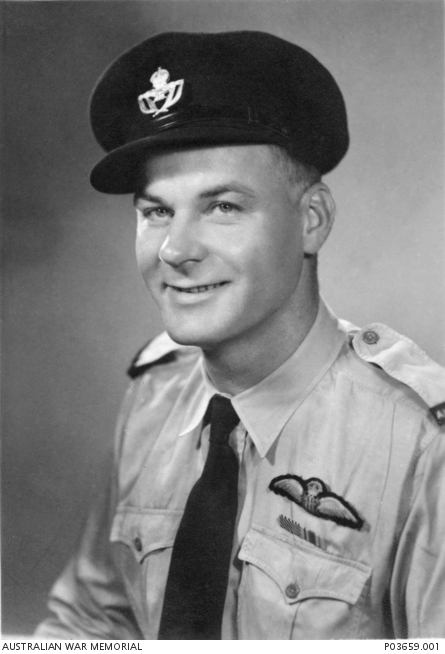| Accession Number | P03659.001 |
|---|---|
| Collection type | Photograph |
| Object type | Black & white - Print silver gelatin |
| Maker |
Unknown |
| Date made | c 1945 |
| Conflict |
Second World War, 1939-1945 |
| Copyright |
Item copyright: Copyright expired - public domain
|
Studio portrait of pilot 407318 Flying Officer (FO) Leonard Alexander 'Toppy' Einsaar RAAF DFM of ...

Studio portrait of pilot 407318 Flying Officer (FO) Leonard Alexander 'Toppy' Einsaar RAAF DFM of Adelaide, SA. FO Einsaar was awarded the Distinguished Flying Medal in 1943 whilst serving with 14 Squadron RAF. He was born in New South Wales on 28 May 1913. He served as a policeman in the 1930s and was also an Olympic rower. He enlisted in the Royal Australian Air Force in 14 September 1940 and trained as a pilot. His DFM citation reads, 'Sergeant Einsaar is a skilful and determined pilot who has completed many sorties. In November, 1942, during a reconnaissance over the sea, he saw two enemy convoys and reported their positions accurately. Some days later, he executed a low level attack on some barges in Benghazi harbour setting two of them on fire. He skilfully accomplished the return flight of 700 miles to base, being the first member of his squadron to achieve this in the type of aircraft he was flying, a Martin Marauder Mark I. During a sortie in December, 1942, his aircraft was severely damaged when attacked by enemy fighters. When his aircraft could no longer be flown, whilst over the sea, 50 miles out from Benghazi, Sergeant Einsaar skilfully came down on the water. The aircraft caught fire but he managed to get clear of the blazing wreckage and, some three and a half hours later, was picked up by a naval launch. This airman has invariably displayed courage and fortitude of a high order.' On 12 April 1943 Einsaar and his crew were forced to ditch their aircraft off Sicily when it was damaged by a German attacker. Five of his crew survived and they were imprisoned first by the Italians and then by the Germans. They eventually escaped and were sheltered by Italian families before they were able to arrange a rendevous with a British motor torpedo boat in 1944. They were evacuated first to Naples and then to Cairo. He was discharged in November 1945.
Related information
Conflicts
Related Objects
- Distinguished Flying Medal : Sergeant L A Einsaar, RAAF, 14 Squadron RAF
- 1939-45 Star : Flying Officer L A Einsaar, RAAF, 14 Squadron, RAF
- Africa Star : Flying Officer L A Einsaar, RAAF. 14 Squadron, RAF
- Italy Star : Flying Officer L A Einsaar, RAAF, 14 Squadron, RAF
- Defence Medal : Flying Officer L A Einsaar, RAAF, 14 Squadron, RAF
- British War Medal 1939-45 with Mentioned in Despatches oakleaf: Flying Officer L A Einsaar, RAAF, 14 Squadron, RAF
- Australia Service Medal : Flying Officer L A Einsaar, RAAF, 14 Squadron, RAF
